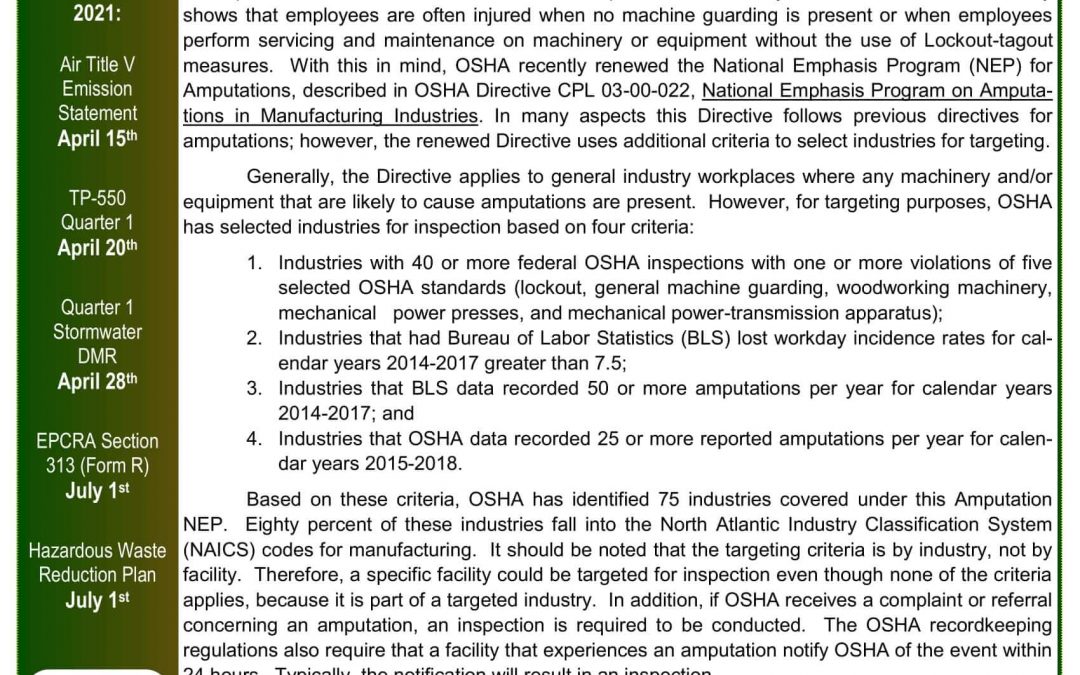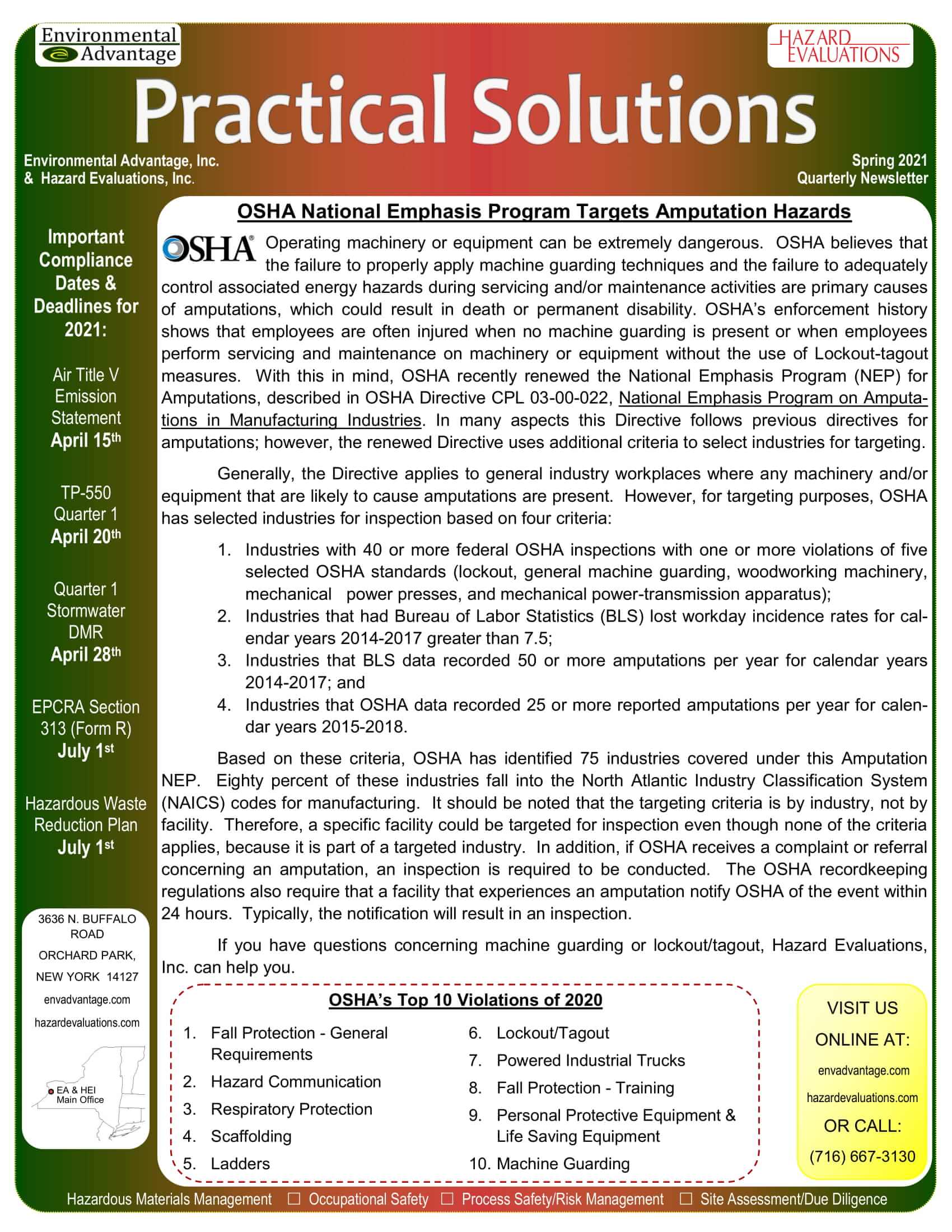OSHA National Emphasis Program Targets Amputation Hazards
Operating machinery or equipment can be extremely dangerous. OSHA believes that the failure to properly apply machine guarding techniques and the failure to adequately control associated energy hazards during servicing and/or maintenance activities are primary causes of amputations, which could result in death or permanent disability. OSHA’s enforcement history shows that employees are often injured when no machine guarding is present or when employees perform servicing and maintenance on machinery or equipment without the use of Lockout-tagout measures. With this in mind, OSHA recently renewed the National Emphasis Program (NEP) for Amputations, described in OSHA Directive CPL 03-00-022, National Emphasis Program on Amputations in Manufacturing Industries. In many aspects this Directive follows previous directives for amputations; however, the renewed Directive uses additional criteria to select industries for targeting.
Generally, the Directive applies to general industry workplaces where any machinery and/or equipment that are likely to cause amputations are present. However, for targeting purposes, OSHA has selected industries for inspection based on four criteria:
- Industries with 40 or more federal OSHA inspections with one or more violations of five selected OSHA standards (lockout, general machine guarding, woodworking machinery, mechanical power presses, and mechanical power-transmission apparatus);
- Industries that had Bureau of Labor Statistics (BLS) lost workday incidence rates for calendar years 2014-2017 greater than 7.5;
- Industries that BLS data recorded 50 or more amputations per year for calendar years 2014-2017; and
- Industries that OSHA data recorded 25 or more reported amputations per year for calendar years 2015-2018.
Based on these criteria, OSHA has identified 75 industries covered under this Amputation NEP. Eighty percent of these industries fall into the North Atlantic Industry Classification System (NAICS) codes for manufacturing. It should be noted that the targeting criteria is by industry, not by facility. Therefore, a specific facility could be targeted for inspection even though none of the criteria applies, because it is part of a targeted industry. In addition, if OSHA receives a complaint or referral concerning an amputation, an inspection is required to be conducted. The OSHA recordkeeping regulations also require that a facility that experiences an amputation notify OSHA of the event within 24 hours. Typically, the notification will result in an inspection.
If you have questions concerning machine guarding or lockout/tagout, Hazard Evaluations, Inc. can help you.
OSHA’s Top 10 Violations of 2020
- Fall Protection – General Requirements
- Hazard Communication
- Respiratory Protection
- Scaffolding
- Ladders
- Lockout/Tagout
- Powered Industrial Trucks
- Fall Protection – Training
- Personal Protective Equipment & Life Saving Equipment
- Machine Guarding
Climate Leadership and Community Protection Act’s Effect on Air Permits
The New York State Department of Environmental Conservation (NYSDEC) adopted 6 NYCRR Part 496, Statewide Greenhouse Gas (GHG) Emission Limits to reduce emissions of greenhouse gases per the requirements of the Climate Leadership and Community Protection Act (CLCPA). New York State passed the CLCPA in 2019 with seven main goals, one of which is to reduce greenhouse gas emissions. The state is working to limit the emissions to 40% of 1990 levels by 2030 and 85% by 2050. The NYSDEC is now preparing for the first annual Greenhouse Gas Emissions Report to be issued this year. The greenhouse gases subject to the statewide emission limit include carbon dioxide, methane, nitrous oxide, perfluorocarbons, hydrofluorocarbons, sulfur hexafluoride, and nitrogen trifluoride. In consideration of the CLCPA, the NYSDEC now requires that applicants of new Air State Facility permits and new Title V permits assess future physical climate risk by determining their GHG emissions based on 20-year Global Warming Potentials (GWPs). The emissions are calculated using emission factors recently developed by the NYSDEC. These emissions factors are currently identified as preliminary/draft values only and are therefore subject to change. Further guidance on CLCPA and how to evaluate compliance is still being developed by the NYSDEC. Control or mitigation measures may be required for applicants whose emissions are determined to pose a significant risk to public infrastructure, neighboring properties, disadvantaged communities, and/or natural resources within the vicinity of the proposed project site.USEPA’s Updated Risk Management Program (RMP) Was Effective December 9th, 2019
The USEPA has finalized changes to the Risk Management Program (RMP) Amendments which became effective on December 19, 2019, to better address potential security risks, reduce unnecessary and ineffective regulatory burdens on facilities and emergency responders, and harmonize rather than conflict with the Occupational Safety and Health Administration’s (OSHA) Process Safety Management (PSM) Standard. The changes are also intended to promote better emergency planning and public information about accidents and continue the trend of fewer significant accidents involving chemicals regulated under the RMP rule. Some of the updates that are part of the finalized changes include: Enhanced Local Emergency Coordination Requirements requiring annual coordination with emergency responders, annual notification drills, field and tabletop exercises (if applicable) and required Public Meeting requirements in the event of a reportable release with environmental impacts. If you have not already had internal discussions on complying with the updated RMP regulations and how its requirements will affect your process and facility, NOW IS THE TIME! HEI provides hands-on assistance to ensure that you understand how the changes will affect your facility and program. With all of the confusion surrounding the new regulations, the associated compliance dates, and what is actually required to achieve compliance, ensure that all of the steps and effort your team takes towards achieving compliance are efficient, effective and can actually be implemented.
Part 350 – NYS Food Donation and Food Scraps Recycling Law
Effective January 1, 2022, large generators of food scraps will be required to separate and donate edible food and separate and recycle all remaining food, if there is an organics recycler within a 25-mile radius. This law was passed in 2019 and is still moving through the legislative process of accepting public comments and revisions. According to the NYSDEC, by June 2021 large generators will be notified of their designation and given an opportunity to submit a waiver from part or all of the requirements.
Those impacted by this new law will include facilities that generate on average more than two tons of wasted food and food scraps per week. Some exclusions to the law include hospitals, nursing homes, adult care facilities, and K-12 schools. Additionally, large generators may petition the NYSDEC for a one-year waiver for undue hardship. For more information, visit the NYSDEC’s website and look for updates to be published in future Practical Solutions issues.
Important Compliance Dates & Deadlines for 2021:
Air Title V Emission Statement – April 15th
TP-550 Quarter 1 – April 20th
Quarter 1 Stormwater DMR – April 28th
EPCRA Section 313 (Form R) – July 1st
Hazardous Waste Reduction Plan – July 1st


